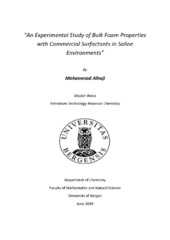“An Experimental Study of Bulk Foam Properties with Commercial Surfactants in Saline Environments”
Master thesis
Permanent lenke
https://hdl.handle.net/1956/20357Utgivelsesdato
2019-06-22Metadata
Vis full innførselSamlinger
- Master theses [170]
Sammendrag
Foam is a fascinating two-phase phenomenon with a wide range of different industrial applications; contaminated-aquifer remediation, separation of waste-waters, enhanced oil recovery, gas leakage prevention and matrix-acidizing treatments to name a few. The success of these applications relies heavily on the choice of the foam-stabilizing agent (e.g., surfactant). The surfactant should provide a set of specific and desirable foam properties under the intended conditions. Since many variables affect surfactants and foam, it is important to understand how and under what conditions various factors contribute to foam properties. The aim of this study is to evaluate salt effects on bulk foam properties with commercial surfactants. Salt tolerance to surfactants and the effect of salinity on foam properties are important first-hand knowledge in all surfactant selection processes. Such knowledge will usually eliminate many surfactant candidates for different saline environments. In this thesis, effect of salt type, concentration, and ionic strength are evaluated in a standard bulk mixer test at ambient conditions with respect to foamability and foam stability. Foamability refers to the “ability” of the surfactant to generate foams under given conditions, while foam stability is understood as a parameter describing changes in the foam with time, immediately after the foam is generated. Two commercial anionic surfactants (i.e., AOS and SDS) and one cationic surfactant (MTAB) are used. Salt effects on bulk foam properties are also evaluated with different complex non-polar phases present (i.e., crude oils from different oil fields). Based on the results obtained, cationic MTAB surfactant shows significantly higher salt tolerances compared to anionic AOS and SDS surfactants. The anionic surfactants are sensitive to relatively low concentrations of CaCl2. Nevertheless, interestingly high tolerances to MgCl2 (> 9 mol/L) are observed with all surfactants. Tests with NaCl and MgCl2 salt solutions adjusted to the same ionic strengths show that foamability with AOS surfactant is more dependent on ionic strength than salt type. The opposite trend is observed with MTAB surfactant, showing a reduction in foamability with increasing salt concentration and ionic strength. Foamability is in general better with anionic surfactants (AOS and SDS) compared with cationic surfactant (MTAB). In the presence of oil, foamability is in general reduced in the presence of oil compared to without oil. Increasing surfactant concentration increases foamability for the two surfactants, nonetheless. We couldn’t observe a clear trend of changes in ionic strength and salt solutions on the foamability when crude oil is added. In addition, the results indicate that there might be a different influence of salinity and ionic strength on bulk foam stability with and without oil present.
